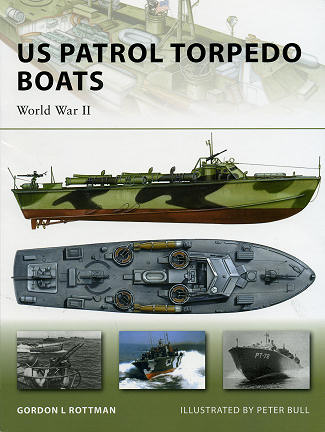 Probably
one of the most glamorous sounding WWII missions was that of the PT boat. It
evokes images of small, fast boats, armed with torpedoes and automatic weapons,
charging in on enemy surface ships at a high rate of speed. Then loosing their
'fish of death' against the now-doomed victim and speeding away while the target
explodes in the background.
Probably
one of the most glamorous sounding WWII missions was that of the PT boat. It
evokes images of small, fast boats, armed with torpedoes and automatic weapons,
charging in on enemy surface ships at a high rate of speed. Then loosing their
'fish of death' against the now-doomed victim and speeding away while the target
explodes in the background.
Well, OK. At least that was the plan.
However, as so often happens, it turns out to be something a bit different. PT
boats rarely went up against larger surface ships like destroyers and cruisers
and when they did, the results were not as spectacular as hoped. Sure, the PT
was able to damage and even sink a destroyer or two, but thanks as much to less
than reliable torpedoes as anything, often the targets got away unscathed. In
fact, the last PT vs Destroyer action was in August of 1943 at Kolombangara, an
action that saw the heroics of PT-109 after it was hit by a Japanese destroyer.
During that operation, 8 PT boats fired 30 torpedoes at 5 Japanese
destroyers without getting a single hit.
In fact, not only was the attack a
'slowly sneak up, fire the torpedo and slowly sneak away' sort of thing, but the
PT boat was much more successful against lightly armed supply shipping. Many of
its exploits were doing things like dropping off agents, rescuing downed pilots,
escorting landing craft to the beaches, providing high speed water transport and
things like that. While not glamorous, these tasks were just as vital.
PT boats were considered to be expendable
boats and so were not provided with much in the way of comfort or armor. They
relied on their speed and maneuverability to get them out of trouble. Built by
Elco and Higgins, over 700 were eventually constructed during the war and most
were burned on the beaches when war was over.
In his book, author Rottman describes the
various major types that were used as well as the organization of units, the way
the boats were operated and a bit of what it was like to have to serve on one of
these boats. All of this is accompanied by superb period
photographs of these vessels, and further enhanced by the artwork of Peter Bull. It makes for a well
rounded publication and a book that I can most highly recommend to you.
September 2008
For more on the complete line of Osprey books,
visit www.ospreypublishing.com. In the US, it is
Osprey Direct at 44-02 23rd St, Suite 219, Long Island City, NY 11101., where you can
get a catalogue of available books.
If you would like your product reviewed fairly and quickly, please contact
me or see other details in the Note to
Contributors.
 Probably
one of the most glamorous sounding WWII missions was that of the PT boat. It
evokes images of small, fast boats, armed with torpedoes and automatic weapons,
charging in on enemy surface ships at a high rate of speed. Then loosing their
'fish of death' against the now-doomed victim and speeding away while the target
explodes in the background.
Probably
one of the most glamorous sounding WWII missions was that of the PT boat. It
evokes images of small, fast boats, armed with torpedoes and automatic weapons,
charging in on enemy surface ships at a high rate of speed. Then loosing their
'fish of death' against the now-doomed victim and speeding away while the target
explodes in the background.